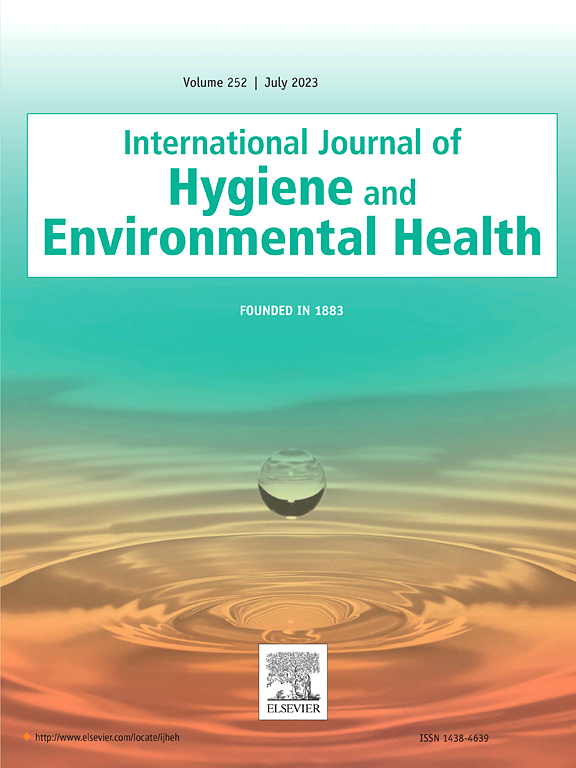Evaluating the impact of occupational noise exposure on workplace fatal and nonfatal injuries in the U.S. (2006–2020)
IF 4.5
2区 医学
Q1 INFECTIOUS DISEASES
International journal of hygiene and environmental health
Pub Date : 2024-09-26
DOI:10.1016/j.ijheh.2024.114468
引用次数: 0
Abstract
Objectives
This study assessed the relationship between occupational noise exposure and the incidence of workplace fatal injury (FI) and nonfatal injury (NFI) in the United States from 2006 to 2020. It also examined whether distinct occupational and industrial clusters based on noise exposure characteristics demonstrated varying risks for FI and NFI.
Methods
An ecological study design was utilized, employing data from the U.S. Bureau of Labor Statistics for FI and NFI and demographic data, the U.S. Census Bureau for occupation/industry classification code lists, and the U.S./Canada Occupational Noise Job Exposure Matrix for noise measurements. We examined four noise metrics as predictors of FI and NFI rates: mean Time-Weighted Average (TWA), maximum TWA, standard deviation of TWA, and percentage of work shifts exceeding 85 or 90 dBA for 619 occupation-years and 591 industry-years. K-means clustering was used to identify clusters of noise exposure characteristics. Mixed-effects negative binomial regression examined the relationship between the noise characteristics and FI/NFI rates separately for occupation and industry.
Results
Among occupations, we found significant associations between increased FI rates and higher mean TWA (IRR: 1.06, 95% CI: 1.01–1.12) and maximum TWA (IRR: 1.10, 95% CI: 1.07–1.14), as well as TWA exceedance (IRR: 1.04, 95% CI: 1.01–1.07). Increased rates of NFI were found to be significantly associated with maximum TWA (IRR: 1.06, 95% CI: 1.04–1.09) and TWA exceedance (IRR: 1.03, 95% CI: 1.01–1.05). In addition, occupations with both higher exposure variability (IRR with FI rate: 1.49, 95% CI: 1.23–1.80; IRR with NFI rate: 1.40, 95% CI: 1.14–1.73) and higher level of sustained exposure (IRR with FI rate: 1.27, 95% CI: 1.12–1.44; IRR with NFI rate: 1.21, 95% CI: 1.05–1.39) were associated with higher rates of FI and NFI compared to occupations with low noise exposure. Among industries, significant associations between increased NFI rates and higher mean TWA (IRR: 1.05, 95% CI: 1.02–1.08) and maximum TWA (IRR: 1.06, 95% CI: 1.04–1.08) were observed. Unlike the occupation-specific analysis, industries with higher exposure variability and higher sustained exposures did not display significantly higher FI/NFI rates compared to industries with low exposure.
Conclusions
The results suggest that occupational noise exposure may be an independent risk factor for workplace FIs/NFIs, particularly for workplaces with highly variable noise exposures. The study highlights the importance of comprehensive occupational noise assessments.
评估职业噪声暴露对美国工作场所致命和非致命工伤的影响(2006-2020 年)
目标本研究评估了 2006 年至 2020 年美国职业噪声暴露与工作场所致命伤害 (FI) 和非致命伤害 (NFI) 发生率之间的关系。研究采用了生态学研究设计,使用了美国劳工统计局的 FI 和 NFI 数据以及人口统计数据、美国人口普查局的职业/行业分类代码表和美国/加拿大职业噪声工作暴露矩阵的噪声测量数据。我们研究了预测 FI 和 NFI 发生率的四个噪声指标:619 个职业年和 591 个行业年的平均加权时间平均值 (TWA)、最大 TWA、TWA 标准偏差以及超过 85 或 90 dBA 的工作班次百分比。K-means 聚类法用于识别噪声暴露特征的聚类。结果在各种职业中,我们发现 FI 率增加与平均 TWA(IRR:1.06,95% CI:1.01-1.12)和最大 TWA(IRR:1.10,95% CI:1.07-1.14)以及 TWA 超标(IRR:1.04,95% CI:1.01-1.07)之间存在显著关联。NFI 的增加与最大 TWA(IRR:1.06,95% CI:1.04-1.09)和 TWA 超标(IRR:1.03,95% CI:1.01-1.05)显著相关。此外,暴露变异性较高的职业(含 FI 率的 IRR:1.49,95% CI:1.01-1.051.49, 95% CI: 1.23-1.80; IRR with NFI rate:1.40,95% CI:1.14-1.73)和持续暴露水平较高(带 FI 比率的 IRR:1.27,95% CI:1.14-1.73)的职业:1.27, 95% CI: 1.12-1.44; IRR with NFI rate:与低噪声暴露的职业相比,较高的 FI 和 NFI 率与较高的持续暴露水平有关(IRR 与 FI 率:1.27,95% CI:1.12-1.44;IRR 与 NFI 率:1.21,95% CI:1.05-1.39)。在各行业中,观察到 NFI 率增加与较高的平均 TWA(IRR:1.05,95% CI:1.02-1.08)和最大 TWA(IRR:1.06,95% CI:1.04-1.08)之间存在明显关联。结果表明,职业噪声暴露可能是工作场所 FIs/NFIs 的一个独立风险因素,尤其是在噪声暴露高度可变的工作场所。这项研究强调了全面职业噪声评估的重要性。
本文章由计算机程序翻译,如有差异,请以英文原文为准。
求助全文
约1分钟内获得全文
求助全文
来源期刊
CiteScore
11.50
自引率
5.00%
发文量
151
审稿时长
22 days
期刊介绍:
The International Journal of Hygiene and Environmental Health serves as a multidisciplinary forum for original reports on exposure assessment and the reactions to and consequences of human exposure to the biological, chemical, and physical environment. Research reports, short communications, reviews, scientific comments, technical notes, and editorials will be peer-reviewed before acceptance for publication. Priority will be given to articles on epidemiological aspects of environmental toxicology, health risk assessments, susceptible (sub) populations, sanitation and clean water, human biomonitoring, environmental medicine, and public health aspects of exposure-related outcomes.

 求助内容:
求助内容: 应助结果提醒方式:
应助结果提醒方式:


